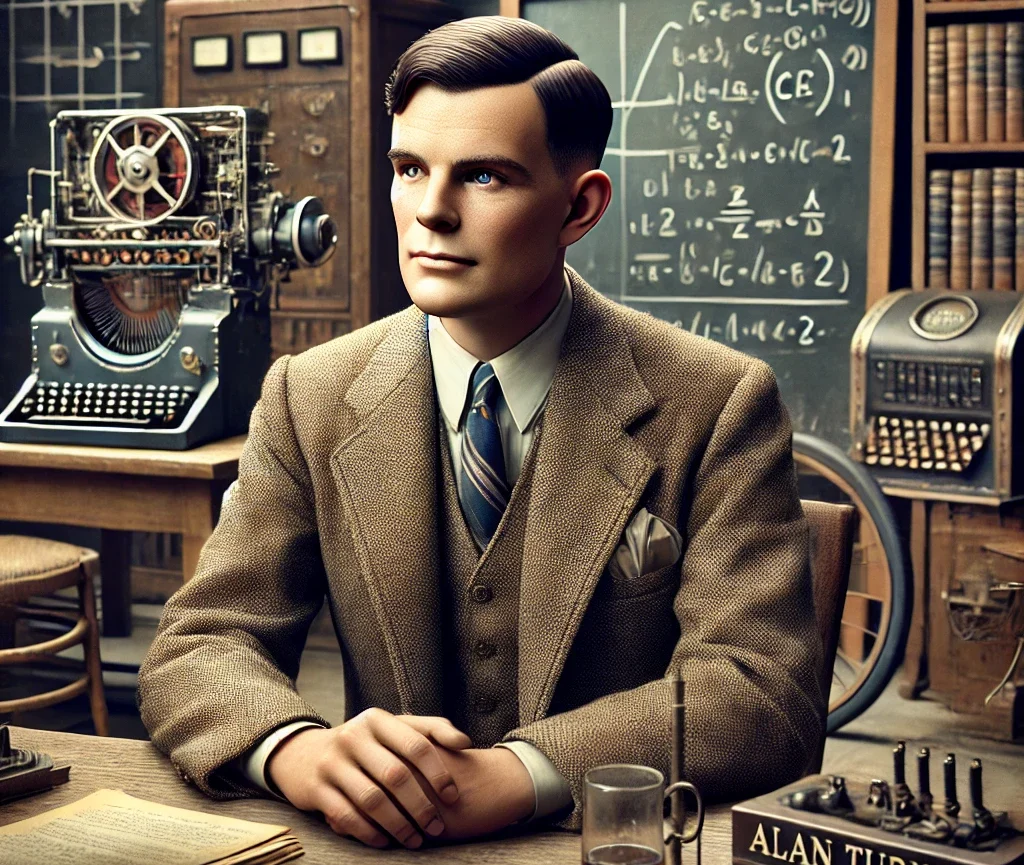Alan Mathison Turing, often hailed as the father of artificial intelligence (AI) and modern computer science, was a visionary whose groundbreaking work laid the foundation for the development of AI. His contributions span various fields, including mathematics, cryptography, and theoretical computer science. This article delves into Turing’s life, his pioneering work, and his lasting impact on AI.
Early Life and Education
Born on June 23, 1912, in Maida Vale, London, Turing displayed an early aptitude for mathematics and science. His education at Sherborne School and later at King’s College, Cambridge, provided a fertile ground for his intellectual growth. At Cambridge, Turing’s brilliance was evident, and he was elected a Fellow of King’s College in 1935.
The Turing Machine: A Theoretical Foundation
In 1936, Turing introduced the concept of the Turing machine in his seminal paper, “On Computable Numbers, with an Application to the Entscheidungsproblem.” The Turing machine is an abstract computational device that manipulates symbols on a strip of tape according to a set of rules. This theoretical construct provided a formalization of the concepts of algorithm and computation, which are fundamental to computer science.
The Turing machine’s significance lies in its ability to simulate the logic of any computer algorithm, making it a universal model of computation. This concept is the cornerstone of modern computer science and has profound implications for AI. By demonstrating that a machine could perform any computation that a human could, Turing laid the groundwork for the development of intelligent machines.
Cryptography and World War II
During World War II, Turing’s expertise in mathematics and cryptography was instrumental in breaking the German Enigma code. Working at Bletchley Park, the British codebreaking center, Turing developed techniques and machines, such as the Bombe, to decipher encrypted messages. His work significantly contributed to the Allied victory and showcased his ability to apply theoretical concepts to practical problems.
The Turing Test: Defining Machine Intelligence
In 1950, Turing published a landmark paper titled “Computing Machinery and Intelligence,” in which he posed the question, “Can machines think?” To address this question, he proposed the Imitation Game, now known as the Turing Test. The test involves a human evaluator who interacts with both a human and a machine through a text-based interface. If the evaluator cannot reliably distinguish between the human and the machine, the machine is said to exhibit intelligent behavior.
The Turing Test remains a fundamental concept in AI, serving as a benchmark for evaluating a machine’s ability to exhibit human-like intelligence. While the test has its limitations and has been the subject of much debate, it continues to influence AI research and development.
Early AI Research and the Turing Award
Turing’s vision extended beyond theoretical constructs. He was deeply interested in the practical implementation of intelligent machines. In the late 1940s and early 1950s, he worked on the design of the Automatic Computing Engine (ACE) at the National Physical Laboratory (NPL) and later at the University of Manchester. These early computers were among the first to use stored programs, a concept Turing had pioneered.
In recognition of his contributions to computer science and AI, the Association for Computing Machinery (ACM) established the Turing Award in 1966. Often referred to as the “Nobel Prize of Computing,” the Turing Award honors individuals who have made significant contributions to the field of computer science.
Turing’s Legacy in AI
Turing’s work laid the foundation for many of the concepts and technologies that underpin modern AI. His ideas about machine learning, neural networks, and heuristic problem-solving were ahead of their time and continue to influence AI research today.
- Machine Learning: Turing believed that machines could learn from experience, much like humans. He envisioned a machine that could modify its own instructions based on past interactions, a concept that is central to modern machine learning algorithms.
- Neural Networks: Turing’s interest in the human brain and its functioning led him to explore the idea of artificial neural networks. While his work in this area was not fully developed, it laid the groundwork for future research in neural networks and deep learning.
- Heuristic Problem-Solving: Turing’s work on heuristic problem-solving, where machines use rules of thumb to find solutions, has influenced the development of AI algorithms that can tackle complex problems efficiently.
Ethical Considerations and AI
Turing was not only a pioneer in technical aspects of AI but also in considering the ethical implications of intelligent machines. He recognized the potential impact of AI on society and the importance of ensuring that machines are designed and used responsibly.
- Human-Machine Interaction: Turing’s work on the Turing Test highlighted the importance of human-machine interaction. He understood that for machines to be truly intelligent, they must be able to communicate and interact with humans in meaningful ways.
- Ethical AI: Turing’s vision of intelligent machines included the need for ethical considerations. He believed that machines should be designed to benefit humanity and that their development should be guided by ethical principles.
Turing’s Influence on Modern AI
Turing’s influence on AI is profound and enduring. His ideas continue to shape the field, and his legacy is evident in many of the advancements in AI technology.
- Natural Language Processing (NLP): Turing’s work on the Turing Test has influenced the development of NLP, a subfield of AI that focuses on the interaction between computers and humans through natural language. Modern chatbots and virtual assistants, such as Siri and Alexa, owe much to Turing’s pioneering ideas.
- Robotics: Turing’s vision of intelligent machines extends to robotics, where AI is used to create autonomous systems capable of performing tasks in the physical world. From industrial robots to self-driving cars, Turing’s influence is evident in the development of intelligent robotic systems.
- AI in Healthcare: Turing’s ideas about machine learning and heuristic problem-solving have found applications in healthcare, where AI is used to diagnose diseases, develop treatment plans, and improve patient outcomes. AI-driven technologies, such as medical imaging and predictive analytics, are transforming the healthcare industry.
- AI Ethics and Governance: Turing’s recognition of the ethical implications of AI has led to the development of frameworks and guidelines for responsible AI. Organizations and governments worldwide are working to ensure that AI is developed and used in ways that are ethical, transparent, and beneficial to society.
Conclusion: Alan Turing’s contributions to AI and computer science are immeasurable. His visionary ideas and pioneering work laid the foundation for the development of intelligent machines and continue to influence the field of AI. Turing’s legacy is not only in the technical advancements he made but also in his recognition of the ethical considerations and societal impact of AI. As we continue to explore the possibilities of AI, Turing’s work serves as a guiding light, reminding us of the importance of innovation, ethics, and the pursuit of knowledge.




